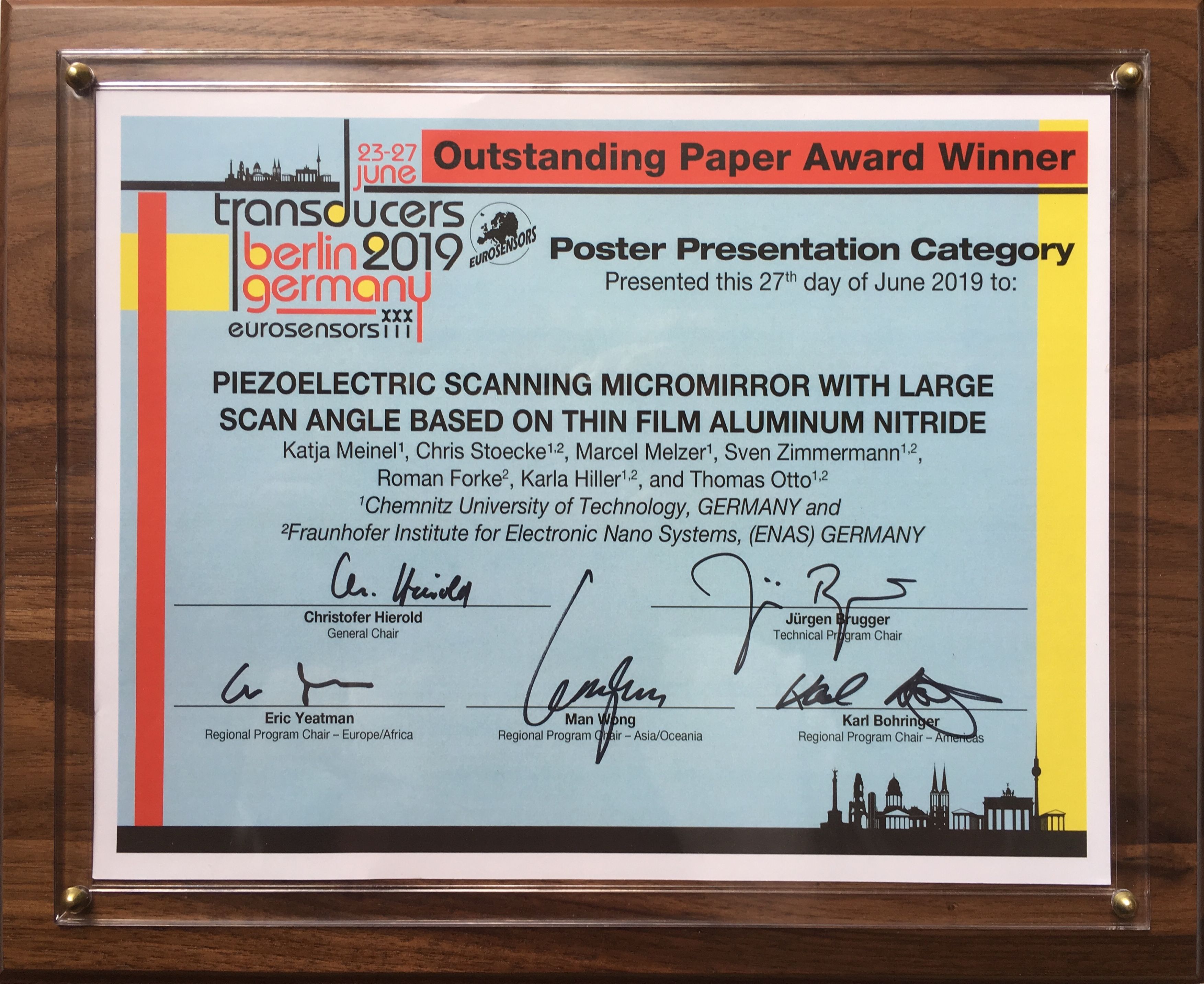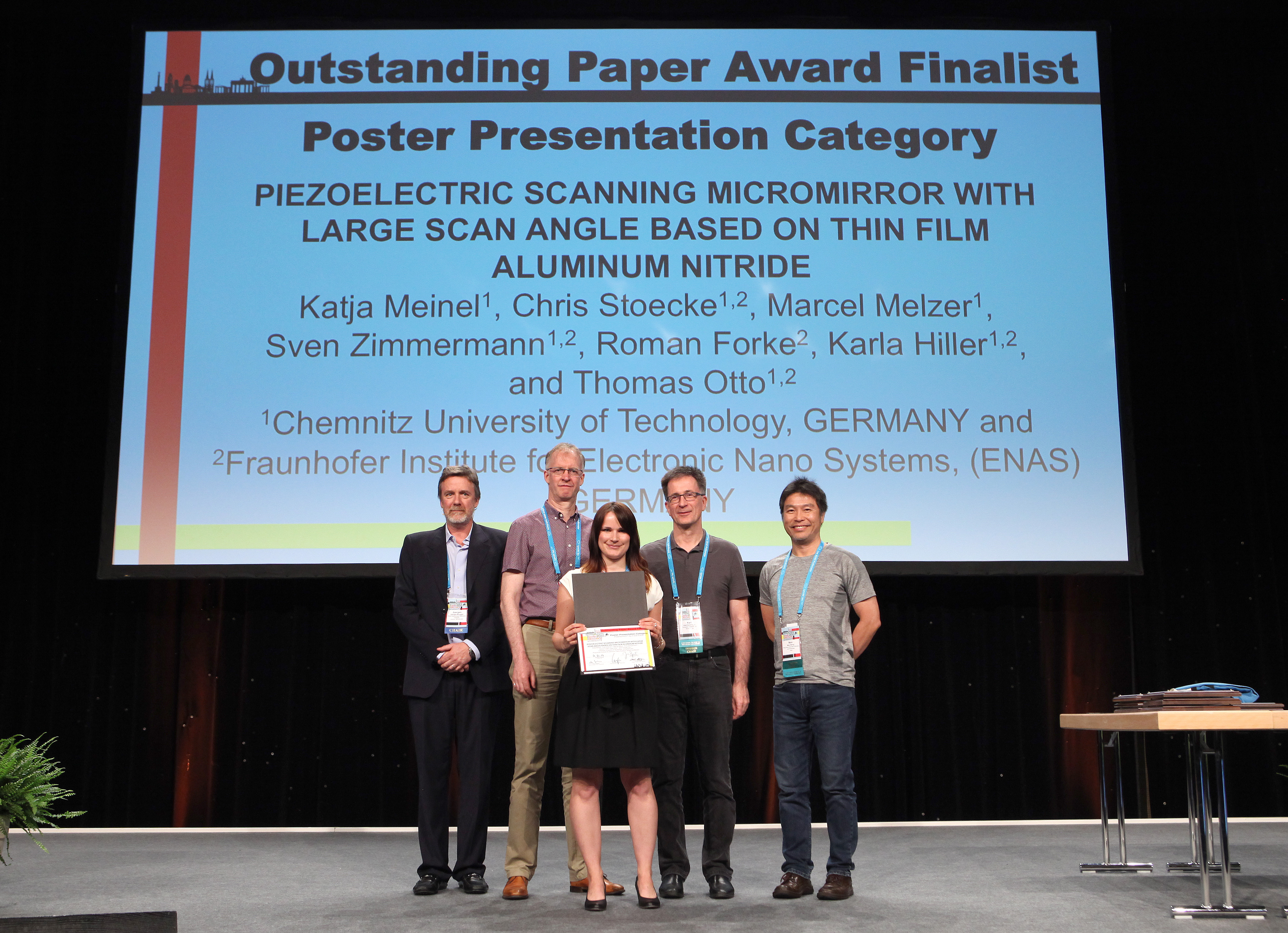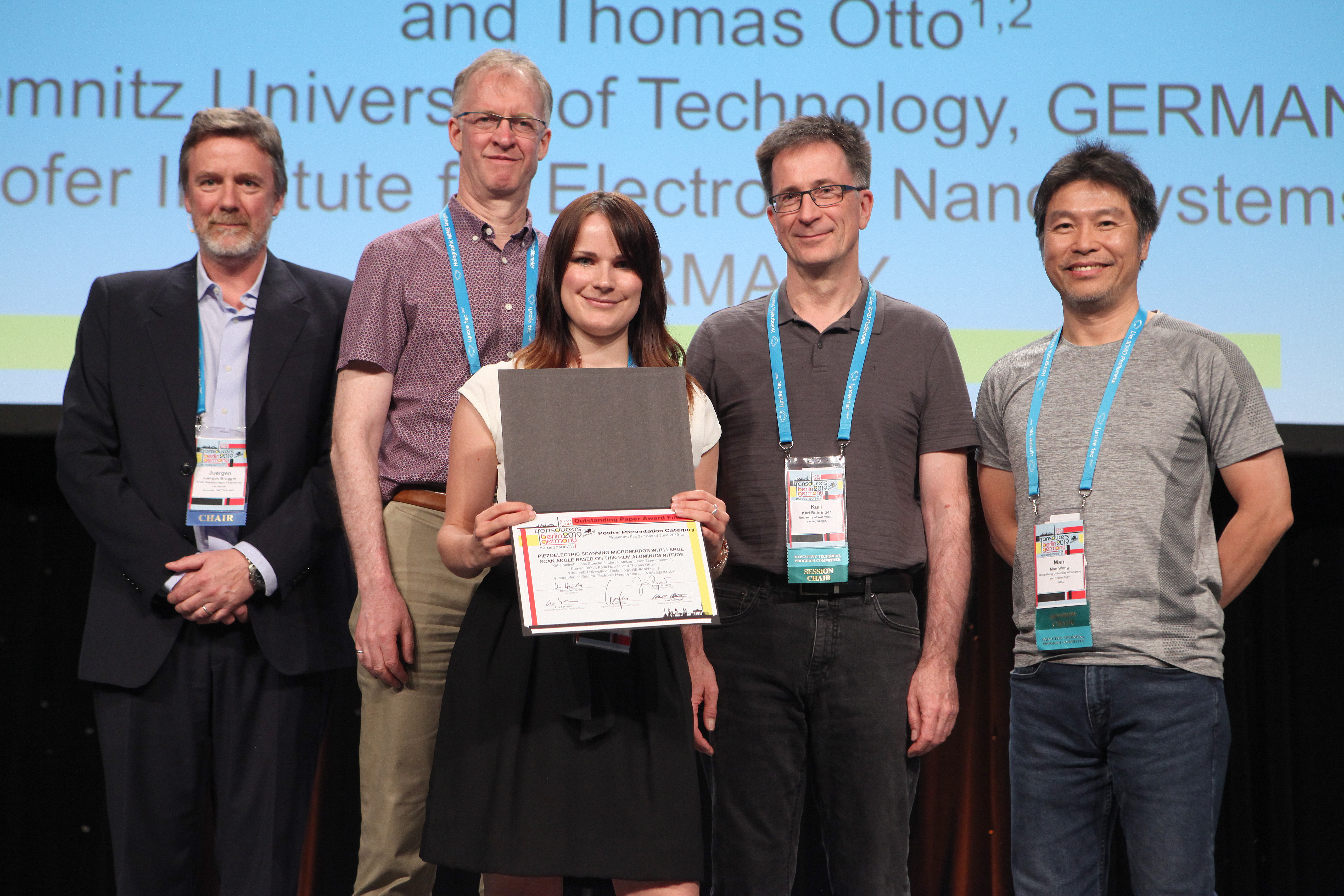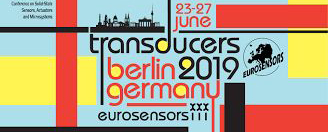Montag, 24. Juni 2019 - Integrated Photonics and Optical MEMS
M3P.058 AC »RELIABILITY OF INTEGRATED LOW-TEMPERATURE PVD PZT FILMS«
Autoren: Daniel Monteiro Diniz Reis1, Sven Rzepka2, and Karla Hiller3
1) Robert Bosch GmbH, GERMANY, 2) Fraunhofer ENAS, GERMANY, and 3) Technische Universität Chemnitz, GERMANY
Lead Zirconate Titanate (PZT) films are important for many applications in MEMS e.g. micro-mirrors, micro speakers, or print heads. In this work reliability of an integrated low-temperature PVD PZT film stack for the important case of unipolar AC stress over temperature and DC offset is discussed. Closing the literature gap, breakdown data with statistical relevance is presented. Comparison with results obtained under DC stress reveals that DC degradation dominates under unipolar AC load.
M3P.065 »PIEZOELECTRIC SCANNING MICROMIRROR WITH LARGE SCAN ANGLE BASED ON THIN FILM ALUMINUM NITRIDE«
Autoren: Katja Meinel1, Chris Stoecke1,2, Marcel Melzer1, Sven Zimmermann1,2, Roman Forke2, Karla Hiller1,2, and Thomas Otto1,2
1) Chemnitz University of Technology, GERMANY and 2) Fraunhofer Institute for Electronic Nano Systems, (ENAS) GERMANY
In this paper micromirrors based on piezoelectric thin film aluminum nitride are presented. The microsystems with 6 mm² footprint achieve a large tilt angle by FEM-based optimization of the lever arm parameters. In resonance the micromirrors reach tilt angles up to 51.3° at 1.9 kHz and a drive voltage of less than 5 V. For higher actuation voltages up to 20 V a scan angle of 104.9° is achieved.
Dienstag, 25. Juni 2019 - Fabrication Technologies II, 11:15 - 11:30 Uhr
T2E.001 »A NOVEL METHOD FOR MEMS WAFER-LEVEL PACKAGING: SELECTIVE AND RAPID INDUCTION HEATING FOR COPPER-TIN SLID BONDING«
Autoren: Christian Hofmann1, Alexander Froehlich2, Jonas Kimme2, Maik Wiemer1, and Thomas Otto1,2
1) Fraunhofer ENAS, GERMANY and 2) Chemnitz University of Technology, GERMANY
A novel method for selective and energy-efficient induction heating of Cu-Sn intermediate layers is presented to support solid-liquid interdiffusion (SLID) bonding at wafer-level. Technological challenges include the coil design for homogeneous heat distribution, the use of high-frequency electromagnetic fields up to frequencies of 2 MHz and the integration of the induction equipment into an industrial waferbond system. Thus, bonding times and pressures could be significantly reduced.
Dienstag, 25. Juni 2019 - Nanoscale Devices and Nanomaterials
T3P.136 »ROLE OF CONTACTS IN CARBON NANOTUBE GIANT PIEZORESISTIVE SENSORS«
Autoren: Simon Böttger1, Christian Wagner2, Florian Lorkowski1, Martin Hartmann1, Georg Heldt1, Jörg Schuster1,3, Danny Reuter1,3, and Sascha Hermann1
1) Chemnitz University of Technology, GERMANY, 2) Helmholtz-Zentrum Dresden-Rossendorf, GERMANY and 3) Fraunhofer Institute for Electronic Nano Systems (ENAS), GERMANY
From the perspective of wafer-level integration technologies, this work presents theoretical and experimental insights on fundamental device properties of single-walled carbon nanotubes (SWCNTs) based giant piezoresistive transducers. The role of contacts in such devices and their contribution to a significant tunneling-related sensitivity enhancement is discussed. Moreover, perspectives for forthcoming sensor generations exposing operation regimes beyond intrinsic sensitivity are revealed.
Mittwoch, 26. Juni 2019 - Integrated Photonics and Optical MEMS
W3P.065 »NANOSTRUCTURED AL SWG REFLECTORS ON THIN LP-SI3N4 MEMBRANES AS (TIO2/SIO2) BRAGG REFLECTOR ALTERNATIVE FOR VIS FABRY-PÉROT INTERFEROMETERS«
Autoren: Christian Helke1, Karla Hiller1, Jan Seiler1, Jens Wolfram Erben2, Thomas Werner2, Danny Reuter2, Marco Meinig2, Steffen Kurth2, and Thomas Otto2
1) Chemnitz University of Technology, GERMANY and 2) Fraunhofer ENAS
We present a Fabry-Pérot-Interferometer for the VIS-range from 555 nm to 585 nm. Two approaches for the FPI reflector are investigated: a (TiO2/SiO2) Bragg reflector on 210 nm thin freestanding LP-Si3N4 membranes as well as a 50 nm thin Al SWG reflector with 140 nm structure dimension and 200 nm structure pitch on 150 nm thin freestanding LP-Si3N4 membranes. Reflectance is up to 97 % realizing a FPI with peak transmittance of 40 %, a FWHM bandwidth of 1.8 nm and a free spectral range of 30 nm.
W3P.067 »TRACEABLE LASER POWER MEASUREMENT USING A MICRO-MACHINED FORCE SENSOR WITH SUB-PICONEWTON RESOLUTION«
Autoren: Zhi Li1, Sai Gao1, Uwe Brand1, Karla Hiller2, Susan Hahn2 and Helmut Wolff1
1) Physikalisch-Technische Bundesanstalt, GERMANY and 2) Technical University Chemnitz, GERMANY
We develop a micro-machined pico-force transducer with integrated Fabry-Perot resonator for traceable measurement of the laser power with high resolution and relatively large measuring range. This silicon MOEMS transducer uses AFM cantilevers with high reflection coating for various wavelengths as the reflector for laser power measurement. First measurements of the radiation pressure of a semiconductor laser revealed a noise limitation of the pico-force transducer of <1 pN.
Mittwoch, 26. Juni 2019 - Optical Elements & Systems, 10:00 - 10:15 Uhr
W1E.002 »NEXT GENERATION OF HIGHLY MINIATURIZED BULK-MEMS FABRY-PÉROT FILTERS FOR INFRARED MICROSPECTROMETERS«
Autoren: Martin Ebermann1, Norbert Neumann1, Silke Hoppe1, Karla Hiller2, Jan Seiler2, Christian Helke2, Marco Meinig3, and Steffen Kurth3
1) InfraTec GmbH, GERMANY, 2) Technische Universität Chemnitz, GERMANY, and 3) Fraunhofer ENAS, GERMANY
We report on the progress in miniaturization of bulk micromachined FP filters and tunable detector modules for the mid infra¬red. The chip size was reduced from 7x7 mm_ to 5x5 mm_, enabling integration into TO5-size detector packages, which is about only one quarter of the formerly used TO8. At the same time a high optical throughput is maintained. An MEMS design with two moveable reflectors is used, which allows for lower actuation voltages and provides negligibly acceleration sensitivity.
 Fraunhofer-Institut für Elektronische Nanosysteme
Fraunhofer-Institut für Elektronische Nanosysteme


